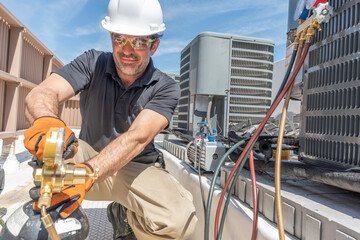Heating and cooling systems are designed to regulate the temperature inside a building. These systems use various methods to transfer thermal energy. Water and air are two common methods used by central HVAC systems. These devices are grouped in an air handling unit with supply and return air fans, a humidifier, and a cooling and preheat coil. Air can also come from outside sources, such as lakes or seawater. These HVAC systems are integrated with the control system.
 HVAC technicians start their day early, gathering their tools and equipment and working on construction sites. Some jobs require technicians to climb rooftops or crawl into tight spaces. They may also have to work with heavy equipment. Generally, HVAC technicians must be physically fit to work in this field. However, there are many physical demands associated with the job. Heating And Air Conditioning Repair can work in very hot and humid conditions and are physically fit to perform its work.
HVAC technicians start their day early, gathering their tools and equipment and working on construction sites. Some jobs require technicians to climb rooftops or crawl into tight spaces. They may also have to work with heavy equipment. Generally, HVAC technicians must be physically fit to work in this field. However, there are many physical demands associated with the job. Heating And Air Conditioning Repair can work in very hot and humid conditions and are physically fit to perform its work.
Heating, ventilation, and air conditioning systems are essential components of any home or business. These components can work independently but often work together. For example, a central heating and air conditioning system will combine air conditioning and furnace components. HVAC professionals may use these terms interchangeably, but these terms refer to different types of units. When used to describe a single system, a professional HVAC contractor can help homeowners decide which type of unit is best for their needs.
There are many different types of HVAC systems, each with its requirements. Natural ventilation is another energy-efficient method for supplementing the HVAC system. Operable windows provide supplemental ventilation and cooling for occupants, and they can improve the occupants’ sense of well-being. They are also an effective solution for exhaust ventilation during construction activities. In addition, some modern systems do not require the use of ducts at all. However, the maintenance and replacement of air filters is a crucial part of HVAC systems.
Air conditioning systems are used in buildings that have multiple floors. Ducts are the largest portion of the system, and they should be cleaned and inspected every two to five years to keep them in good condition. A tripped breaker, dead thermostat batteries, and plants in the ducts can all cause HVAC system failures. The outdoor unit houses the fan and is a common source of ventilation. To prevent these problems, it is important to keep your indoor unit clean and free of weeds.
The basic functions of an HVAC system are regulating the indoor air temperature, providing thermal comfort, and ensuring acceptable indoor air quality. Unfortunately, these systems are often overly complex and difficult to maintain. With nine different parts, it is easy to see why it’s so difficult to maintain a perfect HVAC system. The air returns, the filters, the electrical elements, the outdoor unit, and the coils are just a few of these parts. You may even need to install an additional heating and air conditioning system if your house is very large.
Apprenticeships are another good way to learn about the HVAC industry. Local associations typically offer apprenticeship programs. Apprenticeships usually last between three and five years and are designed to give individuals the experience they need to enter the industry. The job may be unpaid, but the employer will pay you after you have proven yourself during a trial period. Once you’ve got the experience, you may even find a job as a journeyman in the field.
In some buildings, HVAC systems are local. These systems serve one zone or area, such as individual living areas. They don’t connect to a central HVAC system but are part of a larger full-building system. Figure 12 illustrates the differences between local HVAC systems. You can choose one or combine them for the best performance. The best option is to choose the system that meets your needs. In this way, you can avoid problems down the road.
Another way to minimize the risk of mold growth is to install variable occupancy systems. These systems control humidity by reducing the outside air volume when the classroom is empty. In addition to saving energy, variable occupancy HVAC systems help prevent mold growth by reducing the humid outside air when the building is not in use. Unlike other HVAC systems, variable occupancy units can also help reduce humidity. It’s important to maintain the sensors and maintain the system regularly. The variable occupancy system also requires regular calibration.
